
Just a quick post to lighten your day. According to this new promo, the US Open is using Bhangra to promote the upcoming events.
The video was filmed a few days ago in Central Park by ESPN.
Bhangra was also part of the Olympics closing ceremony in London. It makes you wonder though – how can we get more Punjabi athletes represented in sports? And why the sudden interest in Bhangra… ?
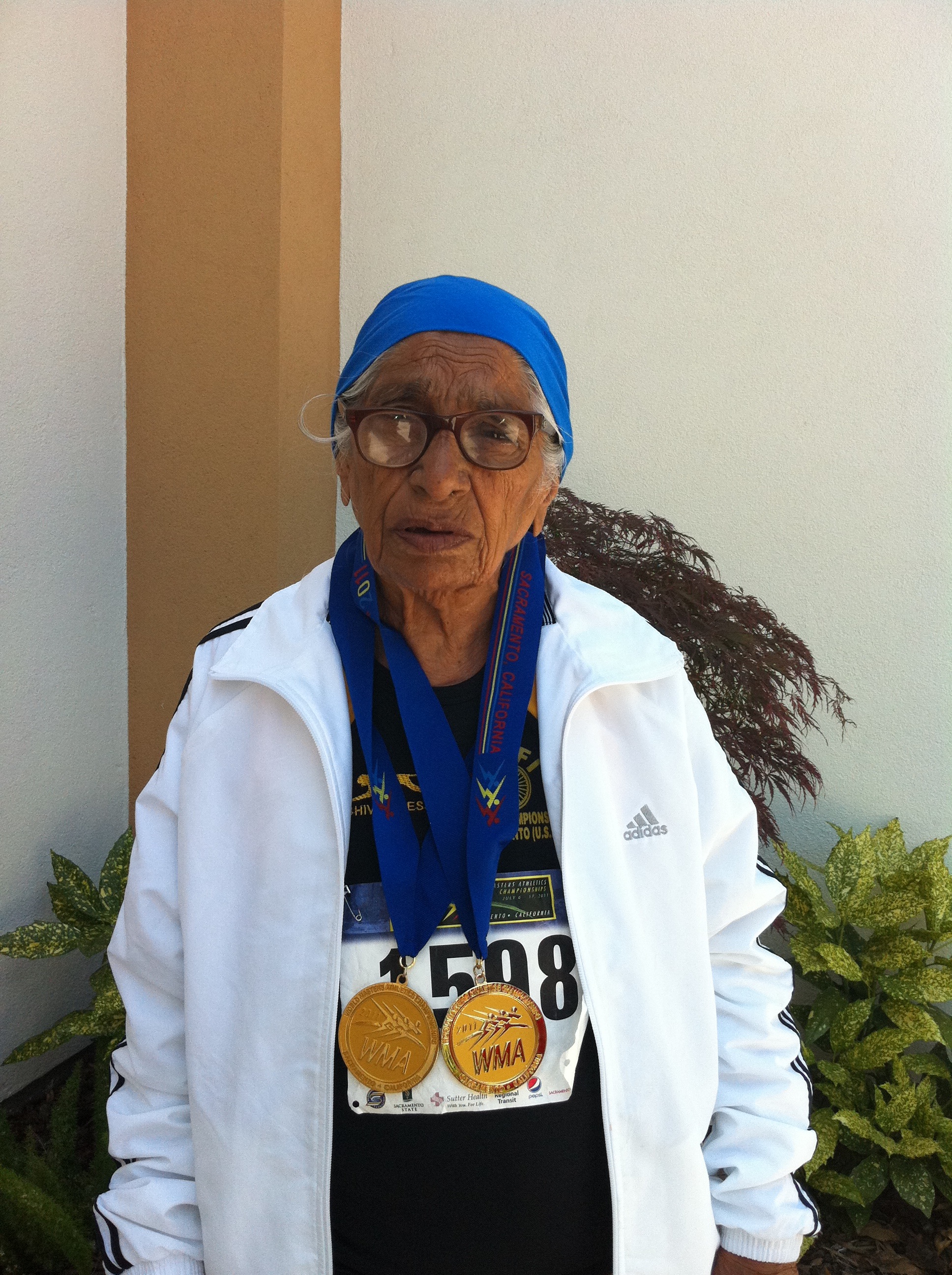 Olympic season will soon be upon us. This year the Games will be held in London. Hopefully we’ll be able to feature biographies on a number of our Sikh athletes that will be competing.
Olympic season will soon be upon us. This year the Games will be held in London. Hopefully we’ll be able to feature biographies on a number of our Sikh athletes that will be competing.
While Fauja Singh has become a celebrity in our community, he is not alone.
Man Kaur, aged 95, of Chandigarh took up running under the encouragement of her son, 72-year-old Gurdev Singh. Last year in Sacramento she received two gold medals in the 90+ age group in the 100m and 200m events. While not a marathoner, it is still an amazing achievement by an amazing woman.
“My son introduced me to athletics. I was hesitant at first, when the idea of stepping into the competitive. arena was thrown at me. But now, running has become a part of my life,” said Mann Kaur, who donned the track pants for the first time in her life last month during the 32nd national masters meet. She won a gold in both the 100m and 200m races in the 90+ age category.
Some have even argued that track and field athletics is one of the purest forms of sport, because it tests speed, strength, power and endurance. What ‘s more, athletic competition is so obviously and easily quantifiable – after all, the tape measure and the photofinish camera don’t lie. However to run the 100M and 200M at the age of 95 requires more than ‘merely’ great natural physical ability. Athletes at this age need a systematic and highly effective training programme carefully crafted to achieve physical ability to run a 200M race.
In a recent exchange with her grandson, he shared his inspiration for physical fitness coming from the example set by the Gurus. He sent the note:
Let us start living in Begumpura Sehar and enjoy Guru’s grace. This is meant to encourage youngsters.
Enjoy some more pictures and articles on Man Kaur below the fold.
With Bhangras and Jakaras – our very own beloved Fauja Singh crossed the finish line to be the first 100 year old to complete a marathon – thus also setting a world record. Running in the Scotiabank Toronto Waterfront Marathon, he may have been last in the pack – but he finished first in the hearts of all. Many of us were following our Torontonian brothers and sisters live tweet as #faujasingh as it began trending in Toronto and through all of Canada.
Here he is crossing the finishing line!

Will the centenarian hang up his Adidas shoes now that he has set this record? HARDLY! Next up – for us Californians, we get the chance to meet him at the upcoming SikhLens Film Festival in Southern California from November 18-20, 2011. Then back to the world stage for Fauja Singh as he will be part of the torchbearer relay for the 2012 London Olympics. Keep on running Fauja! #faujafever
Following in the footsteps of great Sikh marathon runners like Fauja Singh, a young Sikh Ph.D. student named Simran Singh is currently training to run the largest marathon in the world — the New York City Marathon. And he’s running for a good cause. Simran is working with Team in Training and raising money for the Leukemia & Lymphoma Society. This is probably blogworthy in and of itself, but here’s what is extra exciting: Simran was selected by the NYC Marathon as one of just six featured runners this year!

Simran is already representing our community well in the public spotlight as one of the featured runners, but we can all help him get selected as the grand prize winner, meaning more positive representation and mainstream media attention for a turban-wearing Sikh. Hopefully Simran’s presence will help break down stereotypes and barriers (not to mention support cancer research).
Here’s what we can do to support Simran: Go to the ING Featured Runner’s Page, click “View Featured Runners,” and then you can vote for Simran once a day until the contest ends on November 4th. The runner with the most votes wins.
Good luck Simran!

Amritsar, 1946
I’m going to continue on what appears to be our theme of the week here at TLH — Sikhs and sports. I’m not much of an athlete, though I had a good run of Little League baseball when I was a kid in North Carolina. I remember how goofy I felt wearing my team’s baseball cap over my patka and of course a helmet when I was up to bat. Looking back at the photographs, I looked pretty goofy too.
Fast forward a couple of decades, and I find myself in a related dilemma, though hardly an aesthetic one. This time of year in New York City, my favorite (and most efficient) way to get around is on my bike (the kind that requires pedaling). It’s good exercise, it gets me around Brooklyn and other parts of the city often as quick or quicker than public transit, and it leaves no carbon footprint.
As a dastaar-wearing Sikh, I grapple every day with my decision to ride my bike without a helmet — especially in a place like New York City. I’ve had many friends try to convince me to do otherwise, and I’ve tried many experiments of trying to make a helmet work. After talking to many a bike shop employees, my understanding at the moment is that bike helmets and turbans can’t really co-exist effectively. Even if I were to get an extra large helmet and put it over a small dastaar, it would not protect my skull sufficiently because it would sit too high up.
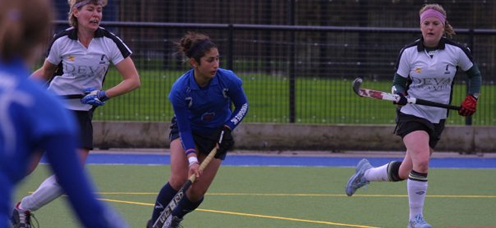
Ashpal Kaur Bhogal
TLH has covered several promising athletes in the Sikh community. Basketball player Darsh Singh, Football player Nuvraj Bassi, and Boxer Andrew Singh Kooner. The list of Sikh athletes is fortunately growing, including Fauja Singh, Pardeep Nagra, and Subaig Singh – some of whom we have covered and others we haven’t had a chance to. Jodha recently updated us on the Bhullar Brothers, potential NBA-ers, Sim Bhullar and younger brother Tanveer Bhullar, both 7-foot-somethings.
The thing about this list, however, is that all of these athletes are men.
It begs the question, then, where is the representation of Kaurs in sports today? After watching news coverage of the growing number of women playing kabaddi in Punjab, and with the popularity of the Women’s World Cup finals this past weekend, it made me think about the importance of sports in the lives of young Sikh girls. Much has been written about why sports are critical for young girls.
A large body of research shows that sports are associated with all sorts of benefits, like lower teenage pregnancy rates, better grades and higher self-esteem… separate studies from two economists offer some answers, providing the strongest evidence yet that team sports can result in lifelong improvements to educational, work and health prospects… Using a complex analysis, Dr. Stevenson showed that increasing girls’ sports participation had a direct effect on women’s education and employment. [link]
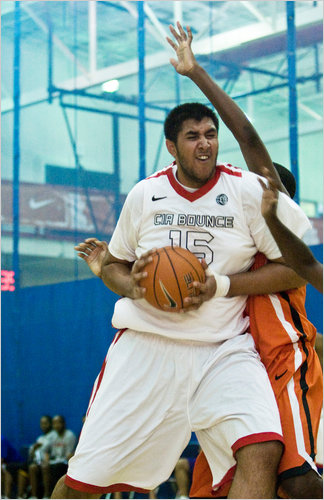 It wasn’t quite the Bhullar I was looking for when I was googling information last week, but it did warrant a revisit.
It wasn’t quite the Bhullar I was looking for when I was googling information last week, but it did warrant a revisit.
Some time ago I wrote an article about how I wish I was a lil bit taller, highlighting the Brother Bhullar – Sim and Tanveer.
Sim is in the press again. The 7’4” Brampton native is all set to join Xavier University in the fall. Until then, he had been helping Team Canada in the FIBA under-19 world championships in Latvia. Sim had a crushing performance against the South Koreans, dumping 24 points and grabbing 14 rebounds. Messed around and got a double-double.
In a New York Times article this week, featuring Sim, Heidi Ueberroth, the president of NBA International stated:
“Having a player from India in the N.B.A. is a question of when, not if. We have no doubt that the elite players from India will emerge.”
I would make a major correction and substitute Punjab for India.
Check out his highlight reel, before clicking below the fold.

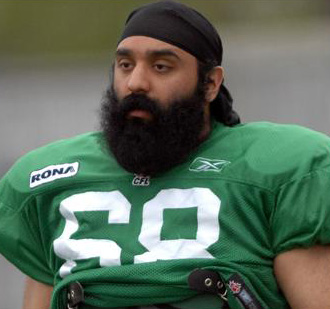 So for this post, I again turn towards Canada, but this time focusing on football (sorry Blighty – let me translate for you – “badibididongbong” or “makubadabuda”, lol).
So for this post, I again turn towards Canada, but this time focusing on football (sorry Blighty – let me translate for you – “badibididongbong” or “makubadabuda”, lol).
Back in the day I wrote a post on this budding football player and since that time many thought he dropped off the map. Despite the lapse in time, this now 28 year old, Singh is still trying to fulfill his football dreams.
At 28, most players who have yet to make an impact would have gone on to the next phase of their life. Bassi says he cannot yet because his football career, in a sense, has yet to start.[link]
Now on the practice team of the B.C. Lions, Bassi is still striving for his opportunity. Despite a career that has been so-far plagued by injury, this Singh remains in chardikala (eternal optimism!)
“That’s why I never gave up,” he said after his first formal workout with the Lions after six seasons Monday. “This is a new time in my life and I have an amazing opportunity.”[link]
Whatever the outcome the Sikh community will still continue to root for him.
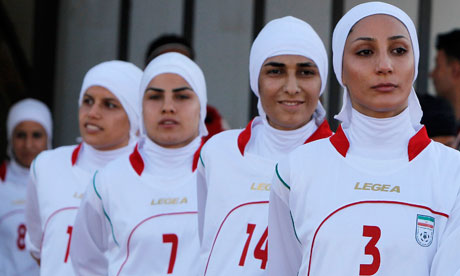
[Note] There has been an update to this post, please see below.
Earlier this month the ruling body for international soccer, FIFA, banned the Iranian women’s team from playing because of their uniforms. The stated reason for the disqualification is that the women’s uniforms, which include a track suit and a head scarf, violated the FIFA dress code. The rules for the 2012 Olympics, according to FIFA, state that,
“[p]layers and officials shall not display political, religious, commercial or personal messages or slogans in any language or form on their playing or team kits.”
Covering the full body is required of women in Iran and when these players were faced with a decision between their faith or football, they chose their faith. Previously, we’ve blogged about the slippery slope of religious symbols, particularly in places like France. Several blogs and opinion pieces have noted that “it seems unlikely that FIFA’s decision is truly independent of any kind of paternalistic or anti-Islamic sentiment, like the anti-head scarf fervor and bigotry going on in France.”
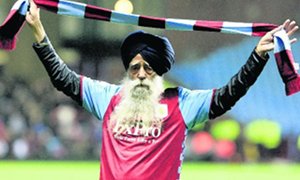 Do Sikhs need to be worried about such policies? Would we need to choose between Sikhi or Soccer? While it seems like this may not be of immediate concern to the Sikh community (because really do YOU know any Sikh
Do Sikhs need to be worried about such policies? Would we need to choose between Sikhi or Soccer? While it seems like this may not be of immediate concern to the Sikh community (because really do YOU know any Sikh football soccer players?!) – it is of concern to us because often times turbans come under similar scrutiny. We have amazing athletes, such as Fauja Singh, who are integrally involved in sports in places like England (there are even Facebook pages dedicated to “Fauja Singh for London 2012 Olympic Torchbearer”). Imagine if this sentiment continues to grow across Europe, as it seems like it is, what will that mean for Fauja Singh and other athletes who wear turbans? So, readers, I’m curious – do we need to worry about this issue?
UPDATE: According to a recent article, Sikhs are impacted by these policies,
Muslims are not the only minorities being affected by the rules of professional sporting bodies, such as FIFA, and those enforcing them. Another player, this time a young Sikh, 14-year-old Sagerpreet Singh, was also prevented from playing because he wears a turban, which the Quebec Soccer Federation argues gives him an “unfair competitive advantage on headers”. Given that turbans do not cover the forehead (the part used for “heading” a ball) it is not clear how this could give an edge to a player.
If you’d like to sign a petition which urges FIFA to reconsider and reevaluate its stance on the dress code restrictions it has placed so that all women can play, you can do so here.
Guestblog by Fakir
I’ve been complaining for several weeks regarding the cricket craze and how educated, conscious south asians should be taking this moment of international spotlight on their ancestral or native countries to highlight their higher expectations for their countries much like what occurred around the world and in Beijing during China Olympics 2008 and educate their peers.
It especially angers me when I see Sikhs rooting for either Pakistan or India, when I see Muslims rooting for India (and Pakistan), etc etc, because these are oppressive machines not harmless patriotic identities. India v. Pakistan is going to happen today in Mohali, Punjab, India. Here is something else that happened in Mohali, Punjab, India just yesterday:
Although I wrote about this almost 6 months ago, I saw another link that I thought I should share. Best wishes to their continued success! (Pagh Salute: Sanaiya’s Dad!)
——————————————————————–
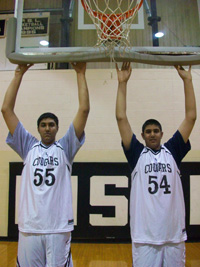 The lyrics once went something like:
The lyrics once went something like:
I wish I was little bit taller,
I wish I was a baller
I wish I had a girl who looked good
I would call her
I wish I had a rabbit in a hat with a bat
and a ’64 Impala
Don’t we wish we were the Bhullar Brothers. The phenoms are listed at 7’4 and 7’2. The sophomore Sim and freshman Tanveer (yes, really, sophomore and freshman) from Toronto are rejuvenating interest at the prep school – The Kiski School.
After a recent article in Slam Magazine’s online edition, the duo are generating tremendous publicity and scout and recruiters are paying attention:
 I am assuming many in Canada probably don’t need an introduction, but as I just discovered the young boxer, I figure I could put the rest of the Langar Hall in the know.
I am assuming many in Canada probably don’t need an introduction, but as I just discovered the young boxer, I figure I could put the rest of the Langar Hall in the know.
This past weekend the young Sikh fighter lost to Jose Silveira of Mexico for the NABA bantamweight title. The loss was due to a judges’ decision after the referee called off the fight after Kooner suffered a cut to the nose from an accidental headbutt by Jose.
Possibly more interesting than this past weekend’s result is Andrew’s story.
In an interview with the Toronto Star, Kooner gave insights into how he got into boxing:
Born in Kettering, England, Kooner immigrated to Canada with his parents as a three-year-old. When he was 13, he joined the local Windsor Boxing Club, not because grew up a fight fan. He was one of the very few Sikh kids in his school and was being singled out on a regular basis.
“I was being tormented a lot,” he said, “and my parents felt boxing was a good way to channel my anger and frustration. Boxing ended up being a blessing.”[link]
The boxer has made previous Olympic appearances, the last time in 2004. Check out his website when you get a chance as well as pictures from his last fight. Talk about a Babbar entourage!
I guess I have a new favorite boxer. What ever happened to Pardeep?
A true Sikh hero, Fauja Singh, turned 99 last Thursday.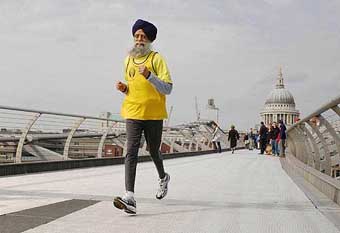
Turbaned Tornado, Fauja Singh turns 99 on Thursday. Here’s wishing this Punjabi icon who manages running marathons at an age not many reach, many happy returns of the day. Besides other gifts that he’d be receiving on his birthday on April 1, this real life ‘Forest Gump’ is all set to give himself a present — by setting yet another marathon record at the ripe age of 99. “I can only sleep, run or walk. I’ll die the day I sit down,” the young nonagenarian had told this scribe in an interview in 2005 on the streets of Ilford, Essex, UK, where he has been living along with his son Sukhjinder Singh since the 1980s. He shifted to UK after having lost his wife and younger son in quick succession in Punjab. [TOI]
I recently heard about an interesting initiative happening in Southern California- a basketball camp for kids, put on by an all Sikh basketball team- the Singh Sensations. [Hat tip: Simrat]
On Saturday March 13, over 100 kids from Los Angeles, Orange County and San Diego gathered to participate in the first ever semi-annual Sikh basketball camp. The camp was held at Khalsa Care Foundation and next door at Pacoima Middle School. Registration began at 9 AM at Khalsa Care Foundation, and by 10 AM, over 100 participants ages 8-18 were stretching and preparing to run basketball drills in the Pacoima Middle School gym.
The camp offered athletic training- the kids ran drills- dribbling, passing, doing layups.
The camp was also part social training- members of the Singh Sensations discussed sportsmanship, teamwork, and how kids should behave on a court.
And finally, the camp was part mentoring on growing up as a Sikh- the Singh Sensations talked about how sports can be used as a metaphor for living as a Sikh. They shared problems had experienced when playing sports in high school and how they had worked through those problems.
Sports are a great way of getting kids together and engaged, and then weaving in topics – like dealing with bullying in the locker room, when growing up Sikh- that might be uncomfortable to talk about otherwise. Sounds like a great initiative!
 Gatka is becoming popular amongst Sikhs and non-Sikhs in the West. Raveena writes that this resurgence in the Toronto area is primarily because of The Annual International Yudh Gatka Tournament that originated in Toronto in 2003. This year the tournament is being held in New Jersey. The Toronto leg of the tournament will on August 23rd the Rexdale Gurdwara Sahib. You can find out more information at Yudh.net.
Gatka is becoming popular amongst Sikhs and non-Sikhs in the West. Raveena writes that this resurgence in the Toronto area is primarily because of The Annual International Yudh Gatka Tournament that originated in Toronto in 2003. This year the tournament is being held in New Jersey. The Toronto leg of the tournament will on August 23rd the Rexdale Gurdwara Sahib. You can find out more information at Yudh.net.
Why is Gatka becoming so popular? Yudh.net writes that, “Not only does Gatka emphasize the physical training of martial arts, but it puts a special focus on ‘mental’ training which is needed to be successful in any sport”. Thus, this traditional Sikh martial arts from the early 17th century is a place to relieve stress, heighten awareness, but also learn sportsmanship and respect-for both people and weapons.
For those of you who attend the Tournament, please let us know how it goes.
Its been a good year so far for Sikhs and Canadian sports. First, we’ve had NHL regular season and playoff games broadcast in Punjabi. We’ve also the first NBA game broadcast in Punjabi. And this year, at the annual Vaisakhi game for the Toronto Raptors, four good looking Sardars sang the Canadian and American national anthems. Performing on drums is Jiwanjot Singh Gill, on dilruba Harman Singh, on dhol is “Tabla Guy“, Gurpreet Singh Chana, and on vocals and harmonium, Dr. Onkar Singh.
Just when you think that everything is hunky-dory for Sikhs in Canada, you hear of an incident like this that makes your cringe. Here’s a first-hand account of an incident that took place at the Toronto Raptors game last Friday night.
My brother, Gagandeep Singh Saluja and I, Simran Kaur Saluja attended a Raptors game at the Air Canada Centre on the night of Friday, January 30, 2009. I witnessed something which disturbed me tremendously. After a great night of getting two of the Raptors’ players to sign our jerseys and getting Jermaine O’Neal’s wristband, my brother and I make our way out to see the post-game show.
He tells me he has to use the washroom. Entering a public washroom is not unlawful in any way. I witnessed many people entering and exiting the same washroom my brother wished to use. A security guard approached my brother, out of all people as he is a visible minority that stands out. The security guard told my brother to get out. For what reason? Well, let me describe my brother to you all. He is a third-year student studying Business Management at UTSC and a proud Sikh youth who wears his turban with pride and joy…A huge Raptors’ fan as well. Gagan asks him “for what” while he tries to make his way to a stall and the security guard starts pushing him and saying “You don’t want to start with me!” He then calls back-up. Gagan finds himself with 4 to 5 security guards on him trying to kick him out. Police officers get involved during this time and start tackling him.
I sensed something wrong while I was standing outside watching the post-game show. I was hesitant in terms of if I should check on my brother in the washroom but I thought it wouldn’t be appropriate for me to do that. I decided to wait for him as I thought that the security guard had let him use the washroom. I wait for about 10 minutes for my brother…I was getting a bit edgy and started looking around for him. I had not seen anything.
Later, the security guard is out of breath and sweaty and attends to the location where I had seen him prior to the whole washroom catastrophe. I ask him “Aren’t you the one who was in the washroom?” He said “yeah.” He knew that I was there waiting for Gagan and after another 10 minutes he tells me, “You might want to make your way out as to whoever you were with is being arrested.” I race outside to find my brother without his turban on, in pain and suffering. When I saw his face…I don’t know how to explain such regret. I keep thinking to myself ‘had I gone into the washroom?! Maybe, just maybe they would not have used such force against him.’ I love my brother a whole lot and I never want to see him hurt. This whole ordeal that happened in Toronto, Canada out of all places is just sad.
I remember going to Nagar Kirtans and being awed by those doing Gatka (i.e. Sikh martial arts)! Their “performances” were eye-catching with action, discipline, determination, and spirituality. Watching Gatka helped me connect with Sikh history at a time when there were little resources around me to learn about Sikhi. This martial art gave me some insight into the concept of a “saint-solider” – one who exemplifies Miri/Piri (spiritual/temporal power). I got to see how a saint-solider physically fought to defend Sikhi.
Lately, I have heard people ask, “Is Gatka a “performance” or a “martial art”? I think the “performance” part of the question comes from those who think Gatka is being done more to please crowds than spiritually connect with Sikhi. Also, some think Gatka techniques are being compromised in order for it to be more “safe” for crowd performances? I personally think, Gatka is both a performance and a marital art, but that does not mean spirituality or technique has to be compromised. What do others think?
A recent BBC show on Gatka addressed how it is becoming a way for Diasporic youth to connect to their Sikh heritage, while focusing on physical fitness. It also touches on non-Sikhs participating in Gatka. Let us know what you think!
p.s. I have always found it empowering to see Sikh girls participating in Gatka, even though I rarely see women on Gurdwara management committees!
Everyone seems to be searching for it online. The Langar Hall got it first. So, for those of you that missed the opening ceremonies of the Olympics, here is a picture of the Punjabi Sikh field hockey players on the 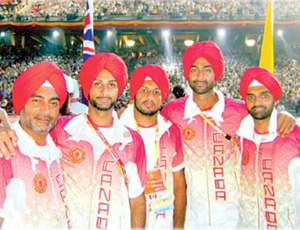 Canadian field hockey team with their pagris (turbans). Pictured from left to right: Assistant Coach Nick Sandhu, Bindi Kullar, Sukhwinder Gabbar Singh, Ravi Kahlon, and Ranjeev Deol.
Canadian field hockey team with their pagris (turbans). Pictured from left to right: Assistant Coach Nick Sandhu, Bindi Kullar, Sukhwinder Gabbar Singh, Ravi Kahlon, and Ranjeev Deol.
For previous coverage of the Canadian Field Hockey Team on The Langar Hall see:
Canadian Field Hockey – individual biographies
Sikhs in the Olympics, Beijing 2008 – for a discussion of their turban-wearing decision
Recent Results:
The team lost their first game against the #1 ranked Australians. They will be playing Pakistan next on Day 5 (Wednesday) at 6am EST. Pakistan lost their first match to Great Britain.
Harwant Kaur is from Punjab and will be competing in the discus throw. It seems that she has recently moved to Australia after a career in the Punjab Police with only dismal prospects. She had previously finished 13th at the Athens Olympics in 2004.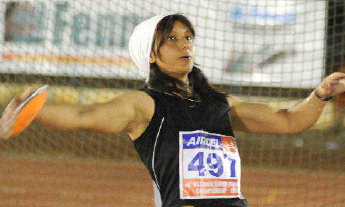
The women’s discus qualifying round is set to begin on Day 7 (Friday, August 15, 2008)
Mandeep Kaur seems to be from Punjab. She is competing in the Women’s 400m race as well as in the women’s 4×400m relay. I could not find a picture or any other information.
The 400m race qualifying rounds begin on Day 8 (Saturday, August 16, 2008) and the 4x400m relay will begin on Day 14 (Friday, August 22, 2008)


